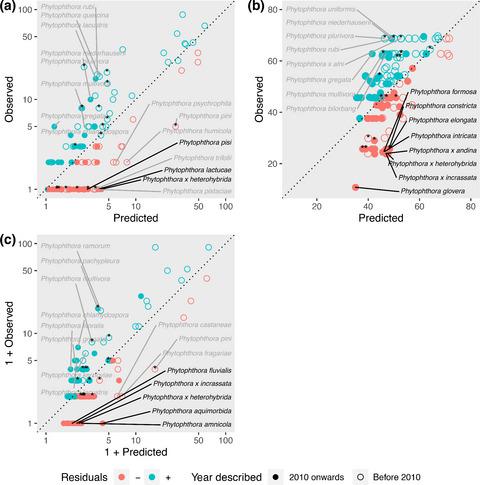当前位置:
X-MOL 学术
›
J. Appl. Ecol.
›
论文详情
Our official English website, www.x-mol.net, welcomes your feedback! (Note: you will need to create a separate account there.)
Evolutionary trait‐based approaches for predicting future global impacts of plant pathogens in the genus Phytophthora
Journal of Applied Ecology ( IF 5.7 ) Pub Date : 2020-12-14 , DOI: 10.1111/1365-2664.13820 Louise J Barwell 1 , Ana Perez-Sierra 2 , Beatrice Henricot 3 , Anna Harris 2 , Treena I Burgess 4 , Giles Hardy 4 , Peter Scott 5 , Nari Williams 6 , David E L Cooke 7 , Sarah Green 3 , Daniel S Chapman 8 , Bethan V Purse 1
中文翻译:

基于进化特征的方法预测疫霉属植物病原体未来的全球影响
更新日期:2020-12-14
Journal of Applied Ecology ( IF 5.7 ) Pub Date : 2020-12-14 , DOI: 10.1111/1365-2664.13820 Louise J Barwell 1 , Ana Perez-Sierra 2 , Beatrice Henricot 3 , Anna Harris 2 , Treena I Burgess 4 , Giles Hardy 4 , Peter Scott 5 , Nari Williams 6 , David E L Cooke 7 , Sarah Green 3 , Daniel S Chapman 8 , Bethan V Purse 1
Affiliation

|
- Plant pathogens are introduced to new geographical regions ever more frequently as global connectivity increases. Predicting the threat they pose to plant health can be difficult without in‐depth knowledge of behaviour, distribution and spread. Here, we evaluate the potential for using biological traits and phylogeny to predict global threats from emerging pathogens.
- We use a species‐level trait database and phylogeny for 179 Phytophthora species: oomycete pathogens impacting natural, agricultural, horticultural and forestry settings. We compile host and distribution reports for Phytophthora species across 178 countries and evaluate the power of traits, phylogeny and time since description (reflecting species‐level knowledge) to explain and predict their international transport, maximum latitude and host breadth using Bayesian phylogenetic generalised linear mixed models.
- In the best‐performing models, traits, phylogeny and time since description together explained up to 90%, 97% and 87% of variance in number of countries reached, latitudinal limits and host range, respectively. Traits and phylogeny together explained up to 26%, 41% and 34% of variance in the number of countries reached, maximum latitude and host plant families affected, respectively, but time since description had the strongest effect.
- Root‐attacking species were reported in more countries, and on more host plant families than foliar‐attacking species. Host generalist pathogens had thicker‐walled resting structures (stress‐tolerant oospores) and faster growth rates at their optima. Cold‐tolerant species are reported in more countries and at higher latitudes, though more accurate interspecific empirical data are needed to confirm this finding.
- Policy implications. We evaluate the potential of an evolutionary trait‐based framework to support horizon‐scanning approaches for identifying pathogens with greater potential for global‐scale impacts. Potential future threats from Phytophthora include Phytophthora x heterohybrida, P. lactucae, P. glovera, P. x incrassata, P. amnicola and P. aquimorbida, which are recently described, possibly under‐reported species, with similar traits and/or phylogenetic proximity to other high‐impact species. Priority traits to measure for emerging species may be thermal minima, oospore wall index and growth rate at optimum temperature. Trait‐based horizon‐scanning approaches would benefit from the development of international and cross‐sectoral collaborations to deliver centralised databases incorporating pathogen distributions, traits and phylogeny.
中文翻译:

基于进化特征的方法预测疫霉属植物病原体未来的全球影响
- 随着全球连通性的增加,植物病原体被更频繁地引入新的地理区域。如果不深入了解行为、分布和传播,就很难预测它们对植物健康构成的威胁。在这里,我们评估了使用生物学特性和系统发育来预测新兴病原体的全球威胁的潜力。
- 我们使用 179 种疫霉菌的物种级特征数据库和系统发育:影响自然、农业、园艺和林业环境的卵菌病原体。我们为 178 个国家/地区的疫霉属物种编制宿主和分布报告,并评估性状、系统发育和自描述以来的时间(反映物种水平知识)的能力,以使用贝叶斯系统发育广义线性混合来解释和预测它们的国际运输、最大纬度和宿主广度楷模。
- 在表现最好的模型中,性状、系统发育和自描述以来的时间共同解释了达到的国家数量、纬度限制和寄主范围的差异高达 90%、97% 和 87%。性状和系统发育共同解释了达到的国家数量、最大纬度和受影响的寄主植物科的差异高达 26%、41% 和 34%,但自描述以来的时间影响最强。
- 与叶面攻击物种相比,更多国家和更多寄主植物科报告了攻击根的物种。宿主通才病原体具有更厚的静止结构壁(耐压卵孢子)和在最佳状态下更快的生长速度。在更多国家和更高纬度地区报告了耐寒物种,但需要更准确的种间经验数据来证实这一发现。
- 政策影响。我们评估了基于进化特征的框架支持水平扫描方法以识别具有更大全球规模影响潜力的病原体的潜力。疫霉的潜在未来威胁包括Phytophthora x heterohybrida、P. lactucae、P. glovera、P. x incrassata、P. amnicola和P. aquimorbida,它们是最近描述的,可能报告不足的物种,具有与其他高影响物种相似的特征和/或系统发育接近性。测量新兴物种的优先性状可能是热最小值、卵孢子壁指数和最适温度下的生长速率。基于特征的水平扫描方法将受益于国际和跨部门合作的发展,以提供包含病原体分布、特征和系统发育的集中式数据库。



























 京公网安备 11010802027423号
京公网安备 11010802027423号